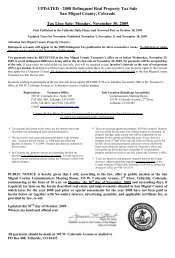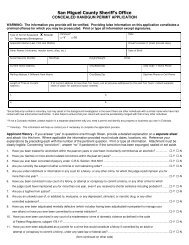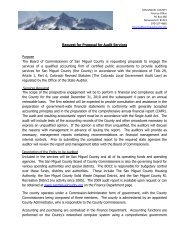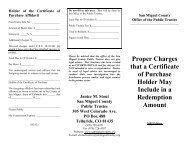colorado retail food establishment rules and ... - Boulder County
colorado retail food establishment rules and ... - Boulder County
colorado retail food establishment rules and ... - Boulder County
You also want an ePaper? Increase the reach of your titles
YUMPU automatically turns print PDFs into web optimized ePapers that Google loves.
Approved <strong>food</strong> source, proper receiving temperatures, <strong>and</strong> proper cold holding before<br />
cooking would also be important if dealing with certain marine finfish due to concerns<br />
with ciguatera toxin <strong>and</strong> scombrotoxin.<br />
I. Food Preparation Process 3 – Complex Food Preparation<br />
Example Flow: RECEIVE → STORE → PREPARE → COOK → COOL → REHEAT<br />
HOT HOLD → SERVE<br />
Foods prepared in large volumes or in advance for next day service usually follow an<br />
extended process flow. These <strong>food</strong>s pass through the temperature danger zone more than<br />
one time; thus, the potential for the growth of spore-forming or toxigenic bacteria is<br />
greater in this process. Failure to adequately control <strong>food</strong> product temperatures is one of<br />
the most frequently encountered risk factors contributing to <strong>food</strong>borne illness. Food<br />
h<strong>and</strong>lers should minimize the time <strong>food</strong>s are at unsafe temperatures.<br />
In addition to the facility-wide considerations, a <strong>food</strong> safety management system<br />
involving this <strong>food</strong> preparation process should focus on ensuring active managerial<br />
control over the following:<br />
o<br />
o<br />
o<br />
o<br />
o<br />
Cooking to destroy bacteria <strong>and</strong> parasites<br />
Cooling to prevent the outgrowth of spore-forming or toxin-forming bacteria<br />
Hot <strong>and</strong> cold holding or using time alone to control bacterial growth <strong>and</strong> toxin<br />
formation<br />
Date marking of ready-to-eat PHF (TCS <strong>food</strong>) held for more than 24 hours to<br />
control the growth of psychrophiles such as Listeria monocytogenes<br />
Reheating for hot holding, if applicable.<br />
Approved <strong>food</strong> source, proper receiving temperatures, <strong>and</strong> proper cold holding before<br />
cooking would also be important if dealing with certain marine finfish due to concerns<br />
with ciguatera toxin <strong>and</strong> scombrotoxin.<br />
4. FDA Retail HACCP Manuals<br />
A. What guidance has been developed by FDA to assist operators of <strong>retail</strong> <strong>and</strong> <strong>food</strong><br />
service <strong>establishment</strong>s in achieving active managerial control of <strong>food</strong>borne illness<br />
risk factors?<br />
FDA, in partnership with Federal, State, <strong>and</strong> local regulators, industry, academia, <strong>and</strong><br />
consumers, has written a guidance document entitled, "Managing Food Safety: A Manual<br />
for the Voluntary Use of HACCP Principles for Operators of Food Service <strong>and</strong> Retail<br />
Establishments 7 ."Commonly referred to as the "Operator's Manual," this document is<br />
designed to assist operators with developing or enhancing <strong>food</strong> safety management<br />
systems based on the process approach to HACCP. The manual presents a step-by-step<br />
procedure for writing <strong>and</strong> voluntarily implementing a <strong>food</strong> safety management system<br />
based on the principles of HACCP. The desired outcome is an operator who employs a<br />
preventive rather than a reactive strategy to <strong>food</strong> safety.<br />
G - 26











